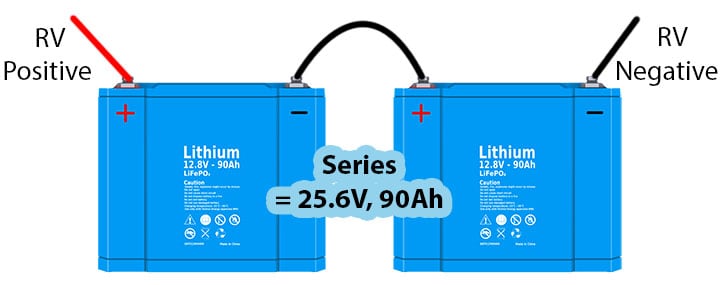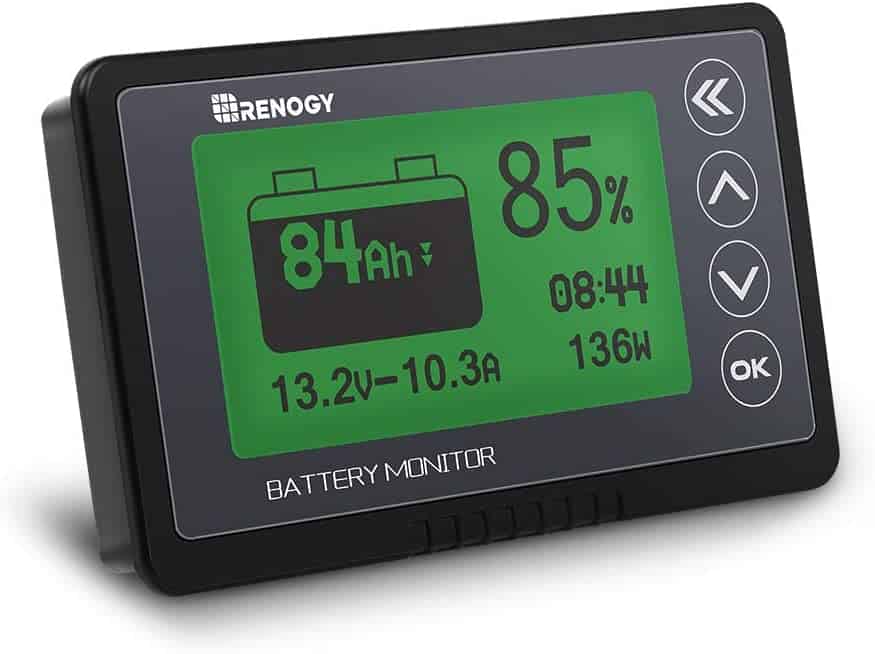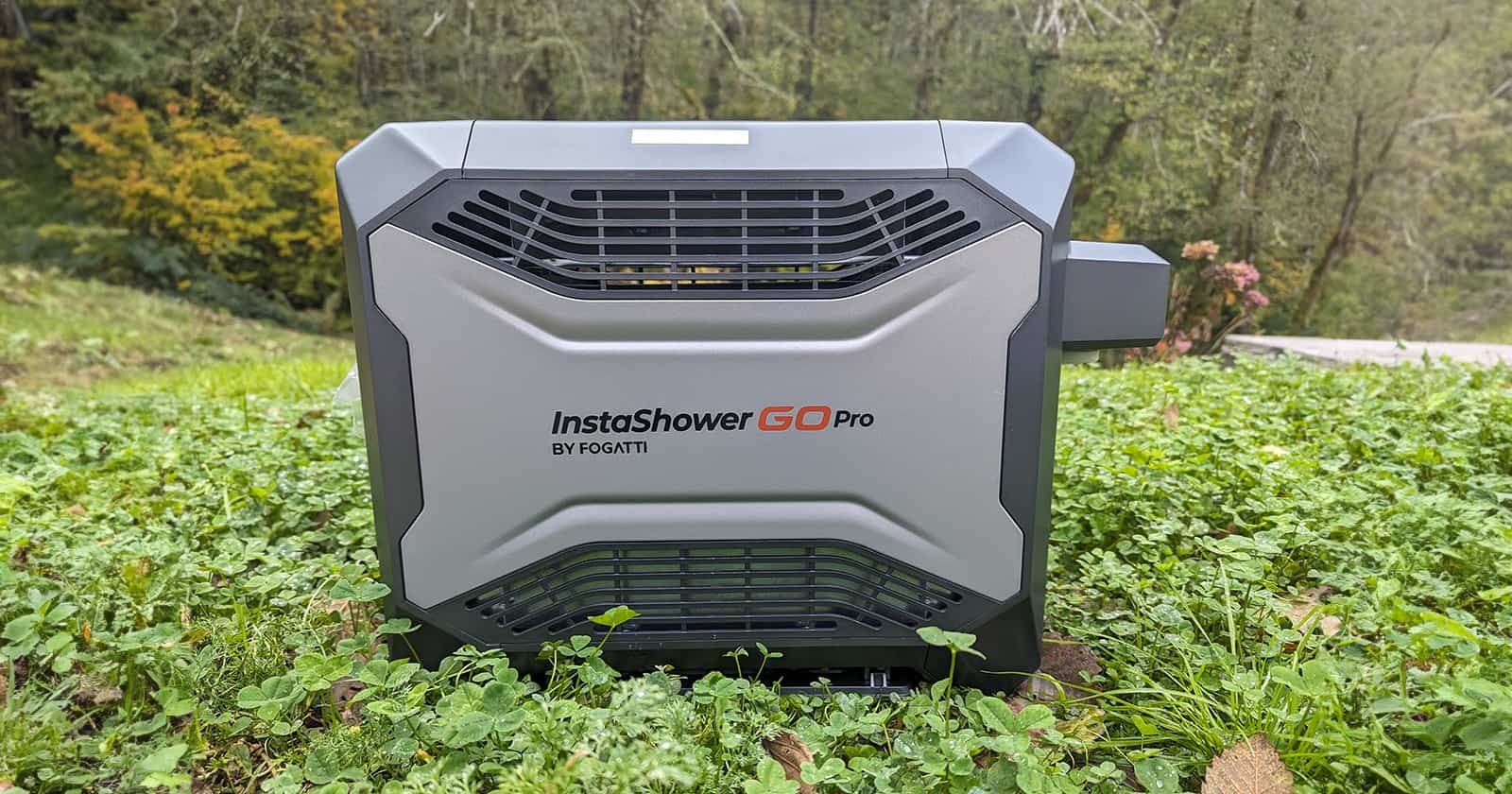So you’ve decided to try boondocking, and like many before you, one of your first questions is How long will my battery last boondocking? It’s a pretty straightforward question, but the answer is relatively individualized to your RV and setup. For clarity, this article will assume that the question refers to how long your batteries will last without a charging source like solar or a generator. You will learn how to figure out your total battery capacity and two ways to estimate how long that battery capacity will last before recharging. We’ll also touch on the most popular boondocking recharging methods to increase your boondocking capability.
Finding Your RV’s Battery Capacity
12V DC battery capacity is typically rated in amp-hours abbreviated as Ah. A batterie’s amp-hours can be found either on a sticker on top of the battery or printed on the side. Some RVs have more than one battery, and motorhomes will have a battery devoted to starting the engine and the rest will power the RV. Typically the house battery (the one that powers your RV’s 12V system) will be labeled as a deep cycle battery, while the one used to fire up the engine will be a starter battery.

Starter Batteries VS Deep Cycle
Like the battery that starts your car or truck, starter batteries are designed to release a lot of power fast to turn over and fire an engine. Deep cycle batteries, on the other hand, are designed to output lower amp draws over a long period and to withstand being depleted and recharged regularly. There are different types of deep cycle batteries used in RVs.
Traditional Flooded Lead-Acid (FLA)
This is the type of battery you have to maintain and add water to periodically. It is the least expensive type of battery, and RVs will commonly have either 12V or 6V versions of FLA batteries installed. If they are 6V batteries, they will be wired in a series to produce 12 volts. More on that later. The important thing to note here is that it is recommended to only drain FLA batteries down to 50% capacity to get the most out of the battery life. In other words, if your FLA battery says 100Ah, following best practices results in half or 50Ah of usable power.
Absorbed Glass Matte (AGM) Batteries
These are often referred to as sealed or maintenance-free because they don’t require you to add water. These are also lead-acid batteries, but instead of a free-floating liquid sloshing around, their electrolyte solution is held in an absorbent fiberglass matt. Sort of like holding a soaked sponge to a plate. RVers like AGM batteries because they don’t require much maintenance, and when used properly, they typically last longer and can charge faster than open FLA batteries. Once again, battery manufacturers recommend only discharging these batteries down to 50% before recharging them.
Lithium Batteries
Lithium batteries are the newest kid on the RV battery block. They combine the maintenance-free aspect of AGM with the ability to withstand a much deeper depth of discharge (DOD). They work on completely different chemicals and metals than lead-acid batteries. The most common type of lithium battery found in RVs is lithium iron phosphate. You will see this marketed using the compound’s chemical formula LiFePO4.
According to RELiON, “LiFePO4 batteries can be continually discharged to 100% DOD and there is no long-term effect. However, we recommend you only discharge down to 80% to maintain battery life.”
In other words, if your lithium batteries are 100Ah, they can technically use all 100Ah.
Parallel Wiring VS Series
So you look in your RV battery compartment and find two batteries. To find the total Ah capacity of your rig, you just add them up, right? Well, not exactly. There are two ways to wire batteries into a battery bank. One increases the voltage, while the other increases the capacity.
Series

If you have multiple batteries connected by the positive and negative terminals, that is a series. Typically RV batteries are wired in a series if they are 6V deep cycle batteries because a series doubles the voltage to bring the battery bank to 12V. The Ah rating remains the same, however. To calculate your RV battery capacity, you simply look for the Ah reading on one of the batteries. 6V golf cart batteries typically come in pretty high capacities of over 200Ah. But, remember, if you stick to the 50% rule, only half of the Ah capacity is usable if you plan on maximizing battery life.
Parallel

If you have two or more 12V batteries connected to your RVs system, they will be wired in a parallel setup. The positive terminals will be connected together, and so will the negative terminals. Wiring batteries in parallel increases the battery bank’s capacity while the voltage remains the same. If you have multiple batteries wired in parallel, they should always be the same voltage and Ah capacity, so multiply the Ah by the number of batteries wired in parallel, and that will give you your total Ah capacity. If they aren’t lithium batteries, remember that you can only use half the total capacity if you want to maximize battery life.
Monitoring Your Batteries While Boondocking
There are several ways to determine how much battery power your RV has left, but the easiest way by far is a battery monitor. A good battery monitor like the Renogy 500A Battery Monitor or the Victron Energy BMV-712 Smart Battery Monitor available on Amazon will tell you your battery’s state of charge, power draw, and how many amp-hours remain.
Finding Out How Long Your RV Battery Will Last
Now that you know where to look for and calculate your total battery capacity, you can start calculating how long your RV battery will last boondocking. You can use two main methods for this. The first requires you to do a little math and guesswork. The other requires much less math and a little more real-world experimentation. If your phone’s calculator is set to scientific mode and there’s a shortcut to it on the home screen, you may fall in love with all the mathematical guesswork of method one. If, however, the previous sentence triggered your fight or flight response or awoke long-forgotten childhood trauma, you can skip to method two.
Method 1: The Math
To calculate how many amp-hours you are using, you must first determine how many amps the devices you want to run draw. If you can pick up the device and look at it, you will most likely find the power consumption information on a sticker or stamped into the plastic casing of the appliance. Devices that run on 12 volts will typically list the number of amps they pull, which makes calculating easy. The formula looks like the following:
Calculating Amp-Hours
(Device Amp Draw) X (Hours You Intend To Run Device Per Day) = (Estimated Ah Used By Device Per Day)
Sometimes, a device’s power consumption will be listed in watts. To find the amps used by a 12V device from watts, you will need the following formula:
Watts / Volts = Amps (It may help to remember “West Virginia” W / V=A)
Recalling from middle school algebra, you may have already figured out that you can rearrange that equation to find out the wattage of a device if you know the amperage.
Watts = Volts X Amps
From Watts To Amps To Amp-Hours
Let’s take a 12V water pump that uses 50W of power when running, and determine how many amp-hours per day a boondocker might use.
50W / 12V = about 4 Amps
Daily Use Estimate: (5 min for dishes) + (10 min for showers) = 0.25 hours
4 Amps X 0.25 Hours = 1 Amp-Hour(s) per day
Calculating Amp-Hours For 120V AC Appliances
If you have an inverter, you can run some of your AC appliances from your batteries. An inverter does two main things.
- It converts the DC (direct current) from your batteries into AC (alternating current).
- An inverter also steps up the voltage from 12V to around 110V so that you can run your 110-120VAC appliances.
There are a couple of key things to remember when calculating amperage draws from AC devices through an inverter.
- If a 110-120V device’s sticker lists its amperage, that amp draw is for the voltage stated on the sticker. A 160W AC fan will draw around 1.4 amps at 120 volts (160W / 120V ≈ 1.4), but the same fan will draw closer to 13 amps from a 12V battery source depending on its state of charge (160W / 12.6V ≈ 12.7 amps).
- It costs energy in the form of heat for the inverter to work. In other words, you will get a power loss of up to 15% when using an inverter. You must add this power loss into your calculations.
Note: A full lead-acid battery will put out between 12.7 and 13 volts when full, and lithium batteries will read up to 14 volts.
Pulling together the above information gets you the formula for calculating a 12V amp draw through an inverter.
First, find the 12V amp draw using the wattage listed on the device sticker (160W in our example).
160W / 12.6V = 12.7A
Next account for the 15% energy loss of the inverter by dividing the amperage by 0.85.
12.7amps / 0.85 ≈ 15 amps total
Adding It All Up
To help you estimate, approximate amp draws for common 12V DC appliances are listed in Table 1 below. Now that you know how to find your total battery capacity in amp-hours and calculate amp-hours from your various appliances, you are ready to figure out how long your RV battery will last. All you have to do is add up all of the estimated amp-hours for each appliance you intend to run per day and divide your total battery capacity by the estimated daily Ah usage.
Say, for example, I estimated my daily amp-hour total was 40Ah, and my rig has a 200Ah battery bank.
Lead Acid Batteries
Keeping with the 50% rule mentioned above, I have 100 usable Ah when using lead-acid batteries.
(200Ah / 2) / 40Ah per day = 2.5 days until batteries are at 50% capacity.
Lithium Batteries
If using lithium, you can use the entire Ah rating.
200Ah / 40Ah per day = 5 days on lithium
Table 1: Approximate 12V RV Appliance Amp Draws
| Appliance | Estimated Amps @12V |
|---|---|
| LED Light | 0.25 |
| Incandescent Light | 3.0 |
| Fluorescent Light | 2.0 |
| Ceiling Fan | 3.7 |
| Propane Furnace 16k BTU | 4 |
| Propane Furnace 25k BTU | 7.5 |
| LP/CO2 Detector | 0.15 |
| Water Pump | 4-8 |
| Range Hood Fan | 2 |
| Absorption Fridge, DC Mode | 14-20 |
| Absorption Fridge, LP Mode | 1.5 |
| 12V Television | 2-3 |
| 12V Outlet, Socket | 10 |
| USB Socket | 2.1 |
| Portable Electric AC/DC Fridge/Freezer | 1-2.5 |
Method 2: The Real World Test
If you read method one and thought it seemed a bit involved, you’re not alone. Fortunately, there is another way to estimate how long your batteries will last boondocking. By testing it at a campground. The simple steps are as follows.
- Find out your total battery capacity.
- Head to an RV park or campground for a couple of days.
- After making sure your battery is full, keep your RV unplugged from the park’s power and pretend you are boondocking. Make sure to power devices and appliances as if you were actually boondocking.
- Keep an eye on your battery monitor periodically to ensure you don’t drain your batteries further than you should. After a full day and night, note how many Ah you have left according to your battery monitor.
- Simple subtraction will tell you how many Ah you used in a 24-hour period. You can then divide the total battery capacity in Ah by the Ah used in a day to find out how many days you would last on a single charge.
- Plug your rig into the RV park when done and recharge your batteries.
If you want a closer estimate, try doing the above test for multiple days and then calculating an average daily Ah usage.
Ways To Extend Your Boondocking Trip
If you’ve run the numbers and feel your battery capacity doesn’t buy you as much boondocking time as you’d like. The following video has some useful information on getting power and recharging your batteries off the grid to extend your boondocking time.
Do you have an awesome boondocking power-saving tip you’d like to share? Tell us about it in the comments.






This type of battery is available as well. Some very useful properties.
http://azimuthsolarproducts.com/product-category/batteries/sio2/
Those can definitely be useful. The SiO2 is sort of like a sub-type of glass-matt (AGM), but with a slightly different electrolyte, I believe. It has an excellent lifespan, can be discharged almost completely on a semi-regular basis, and does very well in cold temps. Some RVers have had great success with that type. I could be wrong due to the lack of non-marketing info about SiO2 batteries, but Lithium batteries have a longer life span and have a better voltage level drop curve as the battery drains. They may also be lighter. But if you will be RVing in very cold or excessively hot weather, SiO2 may be a better choice than lithium, depending on where you plan to store them. Thanks for bringing those to my attention, and thanks for reading.
If only 50% of a lead acid battery’s capacity is “usable”, what happened to the other 50%? Just what happens if I “cross the line” past 50%? Why would a manufacturer specify a given capacity if it’s not true? Isn’t there a cost tradeoff depending on how often and how deeply you discharge any kind of battery?
Thanks for the question. I’m right there with you on not liking this lead-acid battery factoid (I have deep-cycle lead-acid batteries in my rig).
Technically yes, a 100Ah battery will last for around 100Ah. So you can use the total capacity of your battery. Many RVers do routinely drain their batteries past 50%, and one would be hard-pressed to find an RVer who hasn’t run their house batteries dry on at least one occasion. Like anything that wears out, if you do it infrequently enough, you may not notice much difference. But, every battery expert agrees that doing so all the time will drastically shorten the battery’s lifespan. According to battery manufacturer, MkPowered, “If you are always recharging your battery in a complete cycle, you could expect to get just over 220 complete cycles when you drain the battery 80% each day, whereas you would get almost 750 complete cycles if you only discharge 50%.” That’s a significant decrease in life and an increase in money spent on new batteries.
In contrast according to https://battlebornbatteries.com/, “Lithium-ion batteries are better able to sustain deep discharges than their lead-acid counterparts. For example, if you discharge your lead acid battery to 50% or so routinely, that battery will likely give you around 500-800 cycles before it needs to get replaced. By comparison, a lithium-ion battery discharged down to even 20% is said to deliver around 5000 cycles. The extended lifespan of the lithium-ion battery, then, is significant.”
So, you are absolutely correct. Frequent deep discharges will affect the life of any battery. However, the science shows it damages lead-acid batteries (especially flooded) far faster than lithium. So the official recommendation by battery manufacturers is to try not to drain LA below 50% for maximum lifespan. Therefore, while it’s perfectly possible to use the entire capacity all the time, in an effort to not give advice that could cause unneeded damage and shortened lifespans to other RVers’ equipment (batteries), and in order to convey information that most closely follows industry standards and manufacturer’s recommendations, it is recommended in the article to only discharge a lead-acid battery down to 50% charge before recharging it and to have enough battery capacity on board to make that possible when boondocking.
Thank you again for being a Camper Smarts reader. Travel safe, and happy trails.
Very good article, thanks for sharing this!!
Thanks!
Thank you for being a Camper Smarts reader.
Lithium batteries have some history of bad fires. Is there any data on rv fires? If I convert to lithiums from lead/acid do I have to change the inverter and/or converter?
Good questions.
Q: Is there any data on rv fires and lithium batteries?
A: I couldn’t find any specifically for RVs. However AutoinsuranceEZ.com used data collected from NTSB, BTS, and government recall data from Recalls.gov, and broke down incidents of car fires by vehicle and fuel type.
Hybrid vehicles: 3,474 fires per 100K sales
Gas vehicles: 1,529 fires per 100K sales
Electric vehicles: 25 fires per 100K sales
Electric vehicles have very large lithium battery banks and they catch fire less. Also, cell phone batteries experience thermal runaway are one type of lithium battery, the LiFePO4 chemistry in RV lithium batteries is considered very low risk.
Q: If I convert to lithiums from lead/acid do I have to change the inverter and/or converter?
It depends on your converter charger. Many modern converter chargers have a lithium setting. If you’re unsure, it’s best to refer to a manual or contact the manufacturer. If you plan on charging them with an alternator, depending on your setup, it may require a Battery Isolation Manager (BIM). Battery companies like https://battlebornbatteries.com/ can help with what components are needed for your setup.
If you plan on installing solar or increasing your battery bank/capacity considerably, lithium is the top choice. But if you are just looking for something to replace traditional flooded batteries, AGM or the newer version of sealed lead batteries (SiO2) may be the most plug-and-play choice.
Thanks For Reading, I hope that helps.
I question the value of the lithium battery for any but the hard core boondockers. My experience as a camper, auto Tech, and as a marine technician leads me to believe that the AGM battery is the best bang for the buck. It is not unusual to get 5-7-10 years from a battery. Depending on how often you trade your rig, one or two batteries can last for your ownership. Again, in my experience most battery failures are a result of overcharging in the off season. A fully charged battery will get through the winter with only a minor discharge as long as at least one cable. preferably the ground (-) cable is disconnected. At the marina where I worked standard practice is to disconnect the negative cables and leave the battery in the boat for the winter. Winter temperatures routinely well below 0 and many batteries are lasting 10 years or so.
I agree with you there. RVers who only boondock occasionally for one or two nights and spend the rest of their time plugged at an RV park. AGM would most likely be the cost-effective solution. For RVers who plan to go solar and go boondocking more regularly, though, Lithium is able to charge faster and discharge deeper along with other advantages (can be mounted inside the rig for larger banks) besides lifespan in those cases. But a good AGM that is taken care of would certainly work for a solar setup and a more frequent boondocking if lifespan and budget are the only determining factors.
Thanks for being a Camper Smarts reader. Safe travels.
Tanks for the info – The other side of the question “How long will my RV Batteries last while Boon Docking” is the “supply side” (consumption vs production). There are four conventional ways of charging the batteries for a boondocker. 1. RV Generator, 2. Vehicle Alternator 3. Solar Panels and 4. Wind Turbine. To achieve electrical energy independence, #’s 2 and 3 allow the RV boondocking time duration to be constrained by factors other than battery capacity.
RV fuel capacity, potable water availability, need for heating and cooling and propane capacity will limit the boondocking time duration before battery capacity will.
> every battery expert agrees that doing so all the time will
> drastically shorten the battery’s lifespan.
But few correctly interpret the experts. One has to correctly quantify “lifespan”. For batteries, it’s not calendar life or number of cycles but the number of amp hours it has the potential to deliver. It would be accurate to say that a battery used more deeply and more often would “die” sooner, but that doesn’t mean it failed or was damaged. It was just used up more quickly. Greater discharge depth does result in fewer cycles (the “experts” agree) but there is also a greater energy delivery as well. You still get all the Ah you initially paid for, the only thing that changes is how quickly you used it. All batteries die no matter how lightly they’re used or if they’re even used at all, so “preserving” them through limited DOD only carries you so far.
Cycles are an indicator of battery wear but not of “life”. For each cycle there is a quantity of energy delivered corresponding to the depth of discharge, specifically in amp hours. It works out that over the entire range of depth of discharge the delivered amp hours is pretty constant. Meaning, whether you use 10% of your battery thousands of times or 90% of your battery hundreds of times, the net power delivery is roughly the same. If you cycle a battery too lightly you will never realize all it’s potential number of cycles – it will go dead for other reasons before you have enough chances to use it up. If you consistently run it dead you will ultimately kill it, and probably at an inopportune time. So the correct answer is to consider the application – Ah’s to deliver over what time – size the battery/bank to accommodate that plus some margin, and stop there. Buying too big a battery or underusing the one you have is false economy as you lose utility during use, and money in unused life when it ultimately needs to be replaced. The 50% rule has no practical place in RV house battery applications because the use profiles are so varied. There are reasons to use a given DOD from a charge management standpoint – to make sure you have enough power to run your stuff when you need it – but battery preservation is not a valid DOD strategy. Batteries fail for numerous reasons and DOD/cycles is low on that list. You would be hard pressed to actually wear a battery out in RV service before it dies of other causes. The “50% Rule” is often cited in RV circles but when you investigate the specifics of DOD, cycle and calendar life you find there are few if any RV scenarios where that arbitrary DOD point has any effect on service life at all.